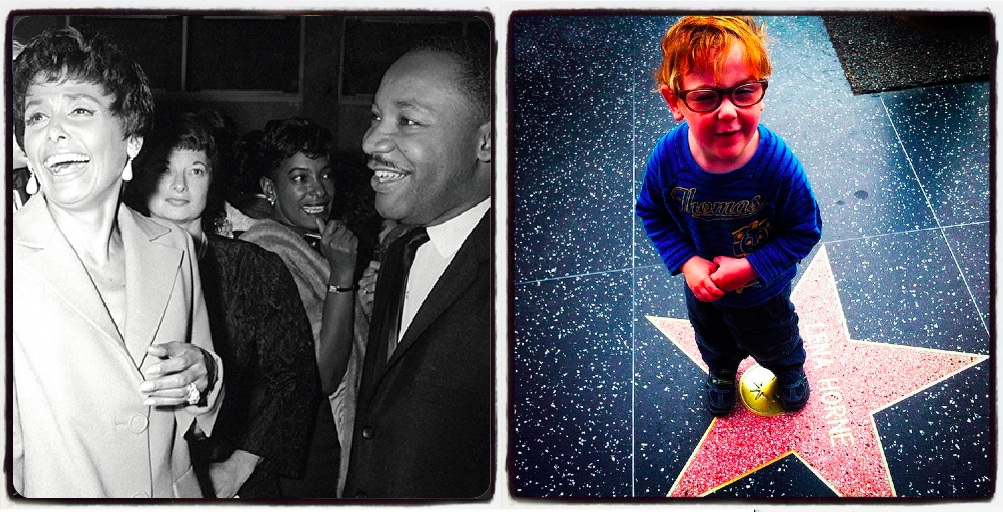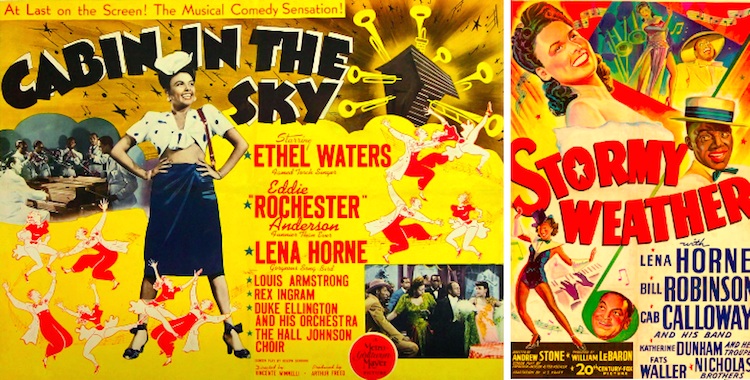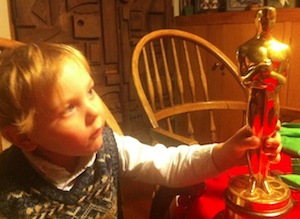 A weekly feature in which my five-year-old son is let loose on the Hollywood Walk of Fame, one of the most popular tourist attractions in Los Angeles, and chooses a star from among the more than 2,500 honorees. His “random” picks sometimes reveal unexplained connections such as the summer day in 2012 when he sat down on the star of actress Celeste Holm and refused to budge. We later learned that the Oscar-winning actress had died only hours earlier. There are five categories on the Walk of Fame: motion pictures, television, radio, music and theater but Charlie tends to favor the movies.
A weekly feature in which my five-year-old son is let loose on the Hollywood Walk of Fame, one of the most popular tourist attractions in Los Angeles, and chooses a star from among the more than 2,500 honorees. His “random” picks sometimes reveal unexplained connections such as the summer day in 2012 when he sat down on the star of actress Celeste Holm and refused to budge. We later learned that the Oscar-winning actress had died only hours earlier. There are five categories on the Walk of Fame: motion pictures, television, radio, music and theater but Charlie tends to favor the movies.
Charlie’s pick on the Hollywood Walk of Fame this week is the brilliant actress, singer, and civil rights activist, Lena Horne. The former MGM star was one of the many people who fought for the national holiday we are celebrating today to honor her friend, Martin Luther King, Jr.
Lena Mary Calhoun Horne was born on June 30, 1917, in the Bedford-Stuyvesant neighborhood of Brooklyn. She started appearing at Harlem’s Cotton Club at the age of 16 and at 25 became the first African American performer to sign a long-term contract with a major studio. Her experiences at MGM, however, were bittersweet. She wrote about them at length and I was lucky enough to see her speak about her Hollywood past in her Tony Award-winning one-woman Broadway show, “Lena Horne: The Lady and Her Music.”
Although she made a major splash in her first MGM outing, Vincente Minnelli’s classic 1943 all-black film, Cabin in the Sky, in which Horne played Georgia Brown opposite Ethel Waters, Eddie “Rochester” Anderson, and Louis Armstrong, most of her subsequent films featured the gorgeous actress singing isolated musical numbers so that her songs could be neatly excised from the prints that played in the South. Hideous but at least she got work and was admired by those who were able to see her. A notable exception to this practice was Stormy Weather, a loan-out to 20th Century Fox, in which Lena starred as Selina Rogers and got to sing the song she’d be identified with for the rest of her life. Stormy Weather also featured Bill “Bojangles” Robinson, Cab Calloway, Fats Waller, the Nicholas Brothers and ballet star Katherine Dunham. If you haven’t seen it, it’s definitely worth seeking out. Fred Astaire later told the Nicholas Brothers that their “Jumpin’ Jive” dance sequence in that film was the greatest musical number he’d ever seen.
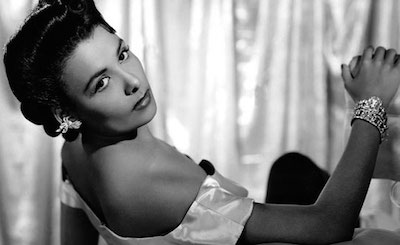 While achieving great fame during her movie career, the indignities Lena Horne was forced to suffer are shocking. But she was never timid about expressing her feelings about it, including her understanding of her success. “I was unique in that I was a kind of black that white people could accept,” Horne said later. “I was their daydream. I had the worst kind of acceptance because it was never for how great I was or what I contributed. It was because of the way I looked.” While entertaining troops at a Kansas army base during World War II, Horne became furious when she realized that the African American soliders were forced to sit in the back of the hall, behind the German prisoners of war. She filed a complaint with the NAACP and MGM pulled her from the tour.
While achieving great fame during her movie career, the indignities Lena Horne was forced to suffer are shocking. But she was never timid about expressing her feelings about it, including her understanding of her success. “I was unique in that I was a kind of black that white people could accept,” Horne said later. “I was their daydream. I had the worst kind of acceptance because it was never for how great I was or what I contributed. It was because of the way I looked.” While entertaining troops at a Kansas army base during World War II, Horne became furious when she realized that the African American soliders were forced to sit in the back of the hall, behind the German prisoners of war. She filed a complaint with the NAACP and MGM pulled her from the tour.
Horne had hoped to play the role of Julie LaVerne in MGM’s 1951 version of Jerome Kern’s Show Boat (she had already played the role when a scene from Show Boat was performed in MGM’s Till the Clouds Roll By a few years earlier) but she lost the part to her close friend Ava Gardner because of the infamous Production Code’s ban on depicting interracial relationships. To add salt to the wound, MGM forced Gardner to practice her singing using Lena’s recordings of the tunes, which infuriated both actresses. In the end, Ava was dubbed by someone else.
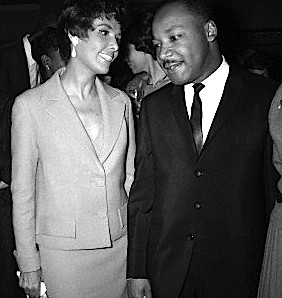 In 1960, Horne was dining at The Luau, a restaurant in Beverly Hills, when she overheard a white man calling her a racial epithet and complaining that she was being served before him. Outraged, she threw a lamp, an ashtray, and three large conch shells at him. “This is America,” she shouted. “You cannot insult people like that.” Lena Horne was present at the March on Washington in 1963 and was near Martin Luther King, Jr., when he made his “I Have a Dream” speech. She sang at many of the rallies that followed the 1965 march from Selma to Montgomery. “My identity is very clear to me now,” she said in an interview when she was 80. “I am a black woman. I’m free. I no longer have to be a ‘credit.’ I don’t have to be a symbol to anybody. I don’t have to be a first to anybody. I don’t have to be an imitation of a white woman that Hollywood sort of hoped I’d become. I’m me, and I’m like nobody else.”
In 1960, Horne was dining at The Luau, a restaurant in Beverly Hills, when she overheard a white man calling her a racial epithet and complaining that she was being served before him. Outraged, she threw a lamp, an ashtray, and three large conch shells at him. “This is America,” she shouted. “You cannot insult people like that.” Lena Horne was present at the March on Washington in 1963 and was near Martin Luther King, Jr., when he made his “I Have a Dream” speech. She sang at many of the rallies that followed the 1965 march from Selma to Montgomery. “My identity is very clear to me now,” she said in an interview when she was 80. “I am a black woman. I’m free. I no longer have to be a ‘credit.’ I don’t have to be a symbol to anybody. I don’t have to be a first to anybody. I don’t have to be an imitation of a white woman that Hollywood sort of hoped I’d become. I’m me, and I’m like nobody else.”
When Lena Horne died on May 9, 2010, at the age of 92, President Obama issued the following statement: “Michelle and I were deeply saddened to hear about the passing of Lena Horne — one of our nation’s most cherished entertainers. Over the years, she warmed the hearts of countless Americans with her beautiful voice and dramatic performances on screen. From the time her grandmother signed her up for an NAACP membership as a child, she worked tirelessly to further the cause of justice and equality. In 1940, she became the first African American performer to tour with an all-white band. And while entertaining soldiers during World War II, she refused to perform for segregated audiences — a principled struggle she continued well after the troops returned home. Michelle and I offer our condolences to all those who knew and loved Lena, and we join all Americans in appreciating the joy she brought to our lives and the progress she forged for our country.”
Take a look at this clip of Lena Horne, age 65, singing her two most famous songs, “Stormy Weather” and “If You Believe” and tell me if this isn’t one of the greatest performers we’ve ever seen.

